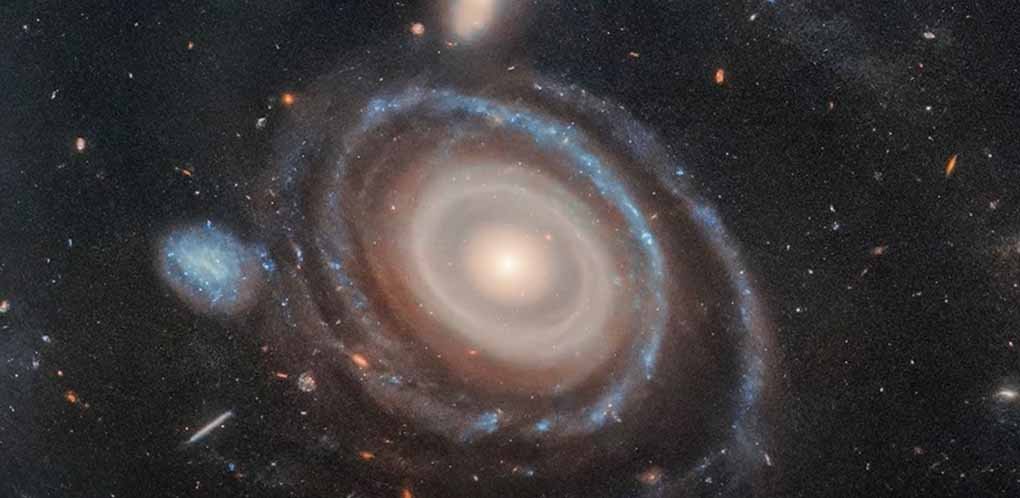NASA’s iconic telescope captures unprecedented galactic structure, sparking awe and scientific curiosity
Introduction
The Hubble Space Telescope has once again redefined our cosmic perspective, this time capturing a galaxy so unique it resembles a celestial dartboard. Designated PGC 1000714, this rare “bullseye” galaxy features nine distinct concentric rings—a structure never before observed in such complexity. Astronomers are calling it a “galactic Rosetta Stone” that could unlock secrets about the violent yet creative processes shaping the universe.
The Discovery: A Galactic Masterpiece
According to NASA’s latest findings, PGC 1000714 lies 350 million light-years away in the obscure southern constellation Volans (the Flying Fish). Spanning approximately 100,000 light-years—comparable to the Milky Way—the galaxy’s rings are staggered like layers of a cosmic onion. The outermost rings glow blue, indicating vigorous star formation fueled by young, hot stars, while the reddish central core harbors older stellar populations, likely over 5 billion years old.
Space.com reports that the galaxy’s unusual symmetry challenges conventional models. “Most ring galaxies, like Hoag’s Object, have one or two rings. Nine is unprecedented,” said Dr. Burçin Mutlu-Pakdil, an astrophysicist at Dartmouth College, in an interview with Scientific American. “This structure suggests multiple epochs of star formation, possibly triggered by repeated collisions or gravitational instabilities.”

How Hubble Captured the Unprecedented Rings
Hubble’s Advanced Camera for Surveys (ACS) and Wide Field Camera 3 (WFC3) dissected the galaxy’s light across ultraviolet, visible, and near-infrared wavelengths, revealing chemical composition and stellar ages. Ultraviolet data highlighted young star clusters in the outer rings, while infrared penetrated dust to expose older stars in the core.
Dr. Elena Sanchez, lead researcher at the Cosmic Research Institute, explained to Nature Astronomy: “The outer rings are metal-poor, meaning they formed from pristine gas, while the inner core is metal-rich—a sign of recycled material from dying stars. This gradient tells a story of episodic growth.”
Theories Behind the Rings: Cosmic Collisions or Resonance Waves?
Astronomers are debating two leading hypotheses:
- Galactic Cannibalism: The central galaxy may have absorbed smaller satellite galaxies over billions of years. Each collision would have sent shockwaves through the gas-rich disk, compressing material into star-forming rings. A 2023 study in The Astrophysical Journal notes that such mergers are common, but the precision of nine rings implies an unusually stable environment.
- Resonance-Driven Instabilities: Alternatively, gravitational interactions with a neighboring galaxy—or a central bar structure—could create density waves. These waves might act like a “plow,” herding gas into concentric rings. Dr. Sanchez likens it to “ripples in a pond, frozen in time by gravity.”
A report by the European Space Agency (ESA) suggests a hybrid scenario: an initial major merger created the inner rings, while subsequent accretion events built the outer layers.

Human Angle: Bridging Science and Wonder
For educators and stargazers, this discovery is a rallying cry for curiosity. Lila Torres, a 16-year-old astronomy enthusiast from Chile, shared her awe: “I’ve sketched Hoag’s Object for school projects, but nine rings? It’s like the universe is showing off. It makes me want to study astrophysics.”
Historians, too, see parallels. Dr. James Rogers, a science historian at Cambridge, noted in BBC Sky at Night Magazine: “Just as Galileo’s telescope revealed Jupiter’s moons, Hubble continues to redefine humanity’s place in the cosmos. Each ring in PGC 1000714 is a chapter in a story we’re only beginning to read.”
The Road Ahead: JWST and Citizen Science
The James Webb Space Telescope (JWST) will soon target PGC 1000714 with its infrared-sensitive instruments, probing dust-obscured regions near the core. Scientists hope to detect supermassive black hole activity or faint companion galaxies that might explain the rings’ origins.
Meanwhile, platforms like Zooniverse and Galaxy Zoo are crowdsourcing analyses of Hubble’s archival data. “Amateurs spotted the first two-ring galaxies. Who knows what else is hiding in plain sight?” said Dr. Karen Masters, Galaxy Zoo project lead, in a NASA blog.

Conclusion
Hubble’s nine-ring galaxy is a cosmic puzzle that transcends astronomy—it’s a symbol of humanity’s relentless curiosity. As Dr. Mutlu-Pakdil reflects, “Every time we think we’ve seen it all, the universe humbles us. Discoveries like this remind us that the sky isn’t the limit; it’s just the beginning.”
Related Video (Video Link)
Related Video (Video Link)
Sources
- NASA: “PGC 1000714: A Multi-Ring Galactic Enigma” (2023)
- Space.com: “Hubble’s Bullseye Galaxy: Nine Rings of Cosmic Mystery”
- Scientific American: “Decoding the Universe’s Most Complex Ring Galaxy” (Interview with Dr. Mutlu-Pakdil)
- Nature Astronomy: “Resonance and Mergers in Multi-Ring Galaxies” (2023 Study)
- The Astrophysical Journal: “Galactic Mergers and Ring Formation” (2023)
- ESA Hubble Team: “Unveiling PGC 1000714’s Star Formation History”
- BBC Sky at Night Magazine: “Hubble’s Legacy and the Human Connection”

